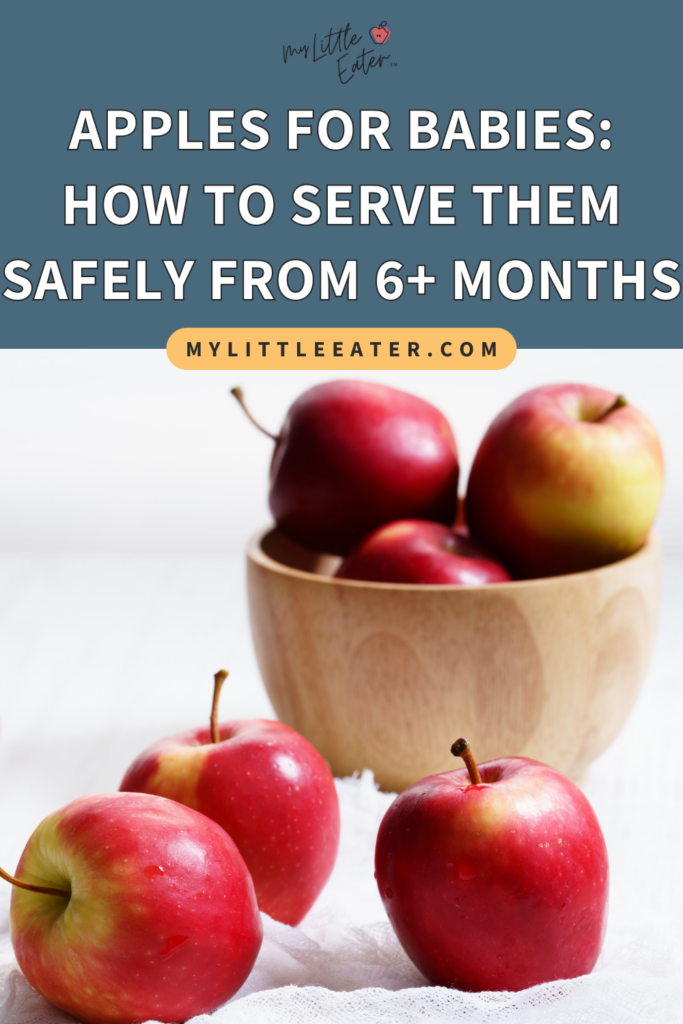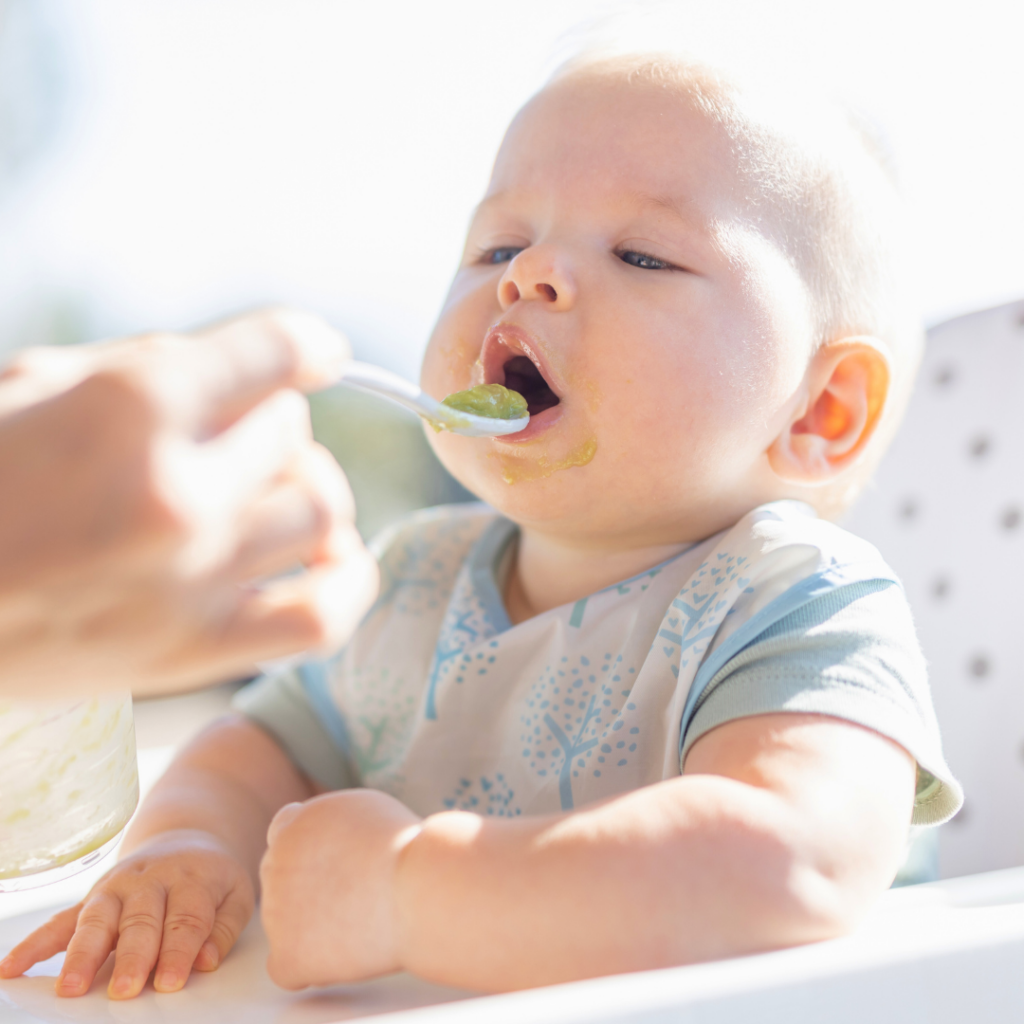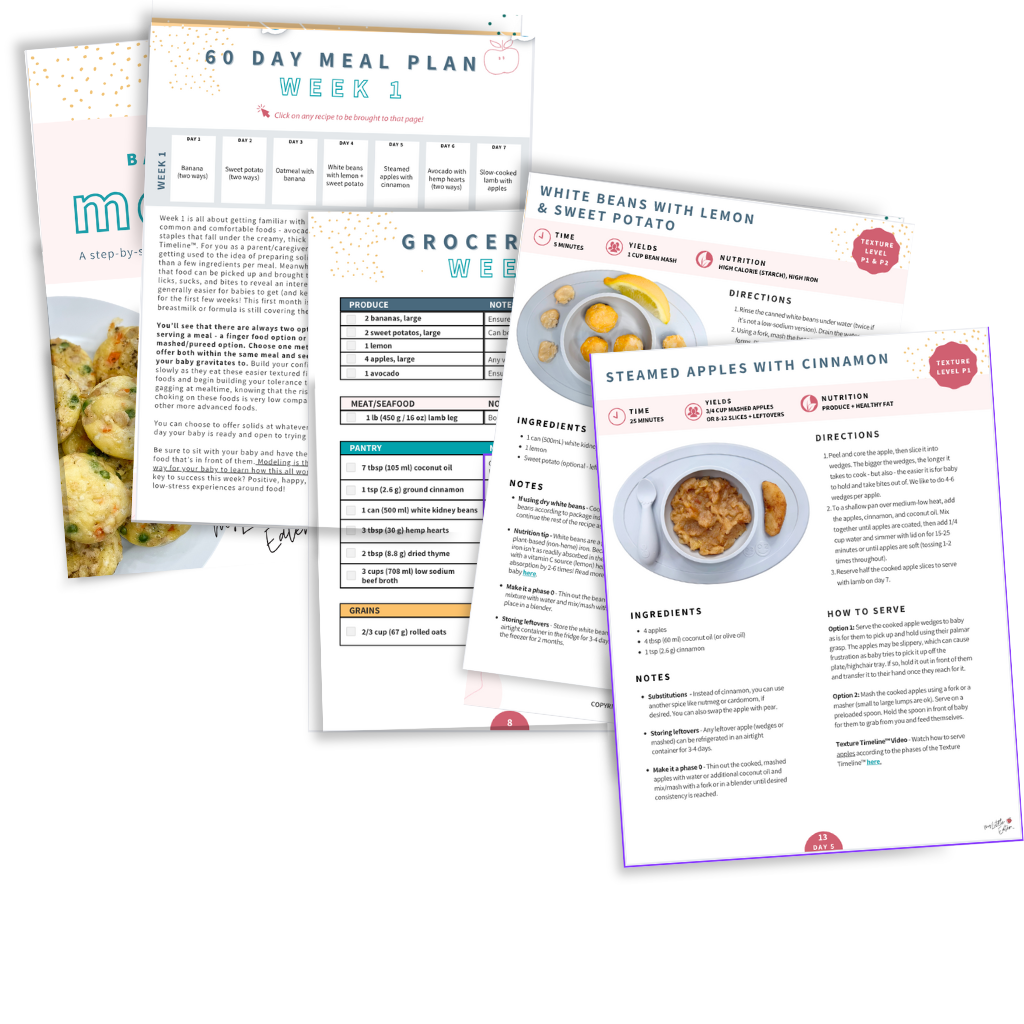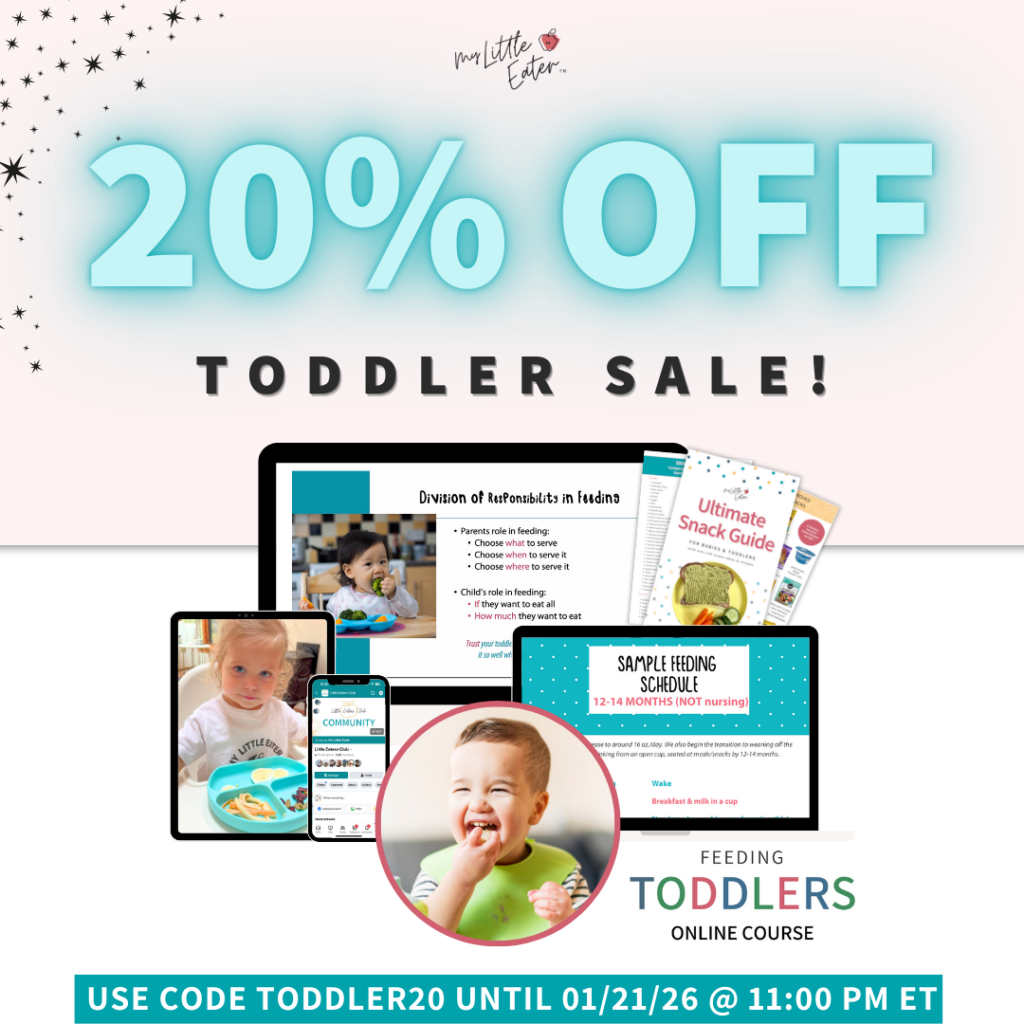Apples are certainly popular, ranking among the top three fruits produced in the world (1). There are over 2500 varieties of apples, and the nutrient profile varies depending on the type.
Overall, this sweet and crunchy fruit is an excellent source of fiber and vitamin C, making them a great food to offer alongside plant-based iron sources (like tofu or beans) to help boost the absorption of iron.
On the downside though, apples are one of the top choking hazards for babies and toddlers! They can still be served, but proper modifications and direct supervision while eating are SO important.
Table of Contents
When can babies eat apples?
Babies can eat apples beginning at around 6 months old when they’re showing all of the developmental signs of readiness to start solids. As with all foods, apples need to be prepared appropriately in order to safely offer them to a 6 month old – but that’s what we’re here for!
Watch babies Sutton & Hannah eat cooked apples!
Sutton is 8 months old in this video and is enjoying a halved piece of apple that has been cooked and seasoned with cinnamon.
Baby Hannah is 6.5 months old in this video and is eating apple two ways.
She has a cooked, mashed version and a cooked, halved version, both seasoned with cinnamon. She’s self-feeding using both her hands and a preloaded spoon.
Are apples a choking hazard for babies?
Yes!
Apples are very firm, hard to chew, and can be slippery. This combination makes it difficult for babies to safely manipulate in their mouth, particularly babies new to eating who are still working on developing their chewing skills.
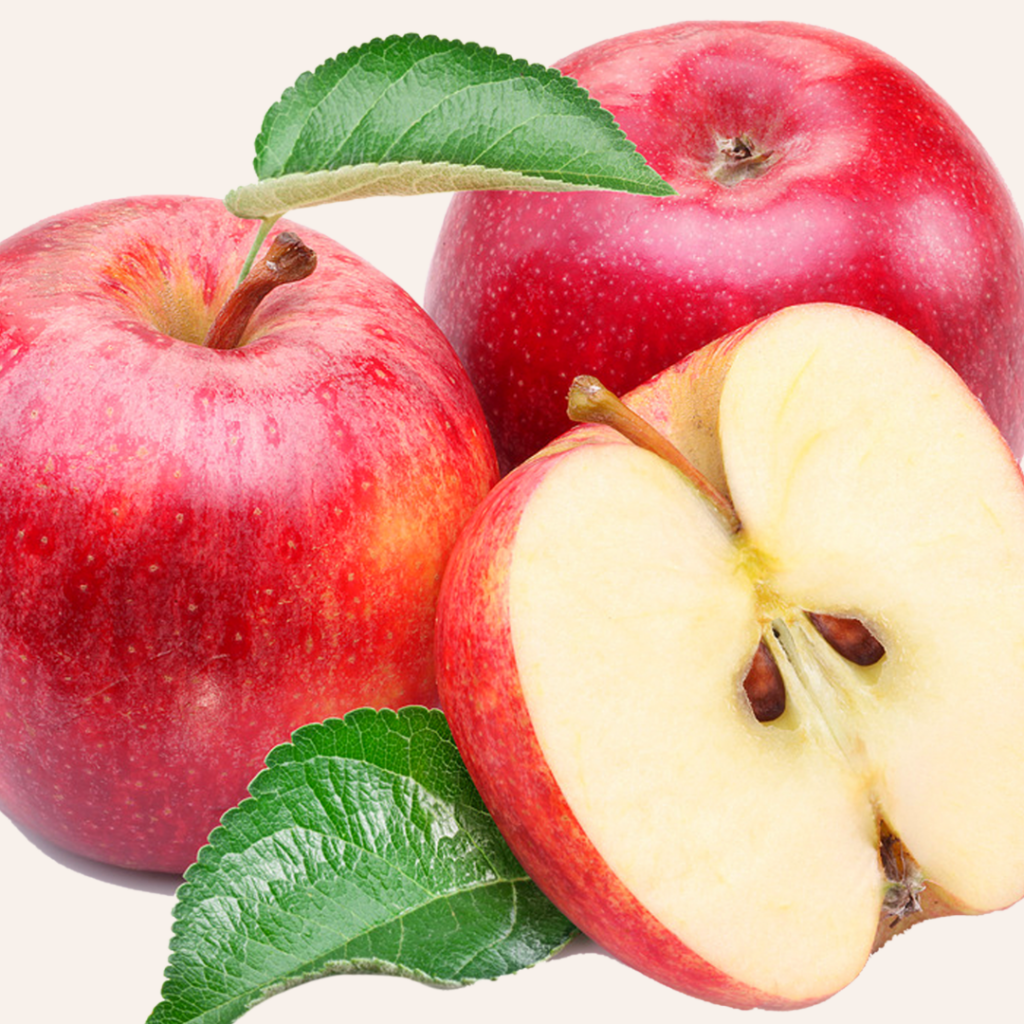
To minimize choking risk, cook apples until they’re soft or slice them thin enough that they are nearly see-through. Following the instructions outlined below will ensure you’re offering them in a safe manner for your baby.
Always make sure you’re offering baby appropriate foods based on their skill level and ability to chew their food thoroughly.
Selecting ripe apples for babies
Since apples come in so many varieties of all colors, you can’t rely on color alone to determine if an apple is ripe (2). Instead, you want to choose apples based on how firm they are. Ripe apples are firm to the touch, this is how you know you’ll get that classic crunch when you bite into them.
If you’re shopping at a market or store where the apples are already picked, firmness will be the best indicator. Choose apples that are firm with no soft spots or bruises (2).
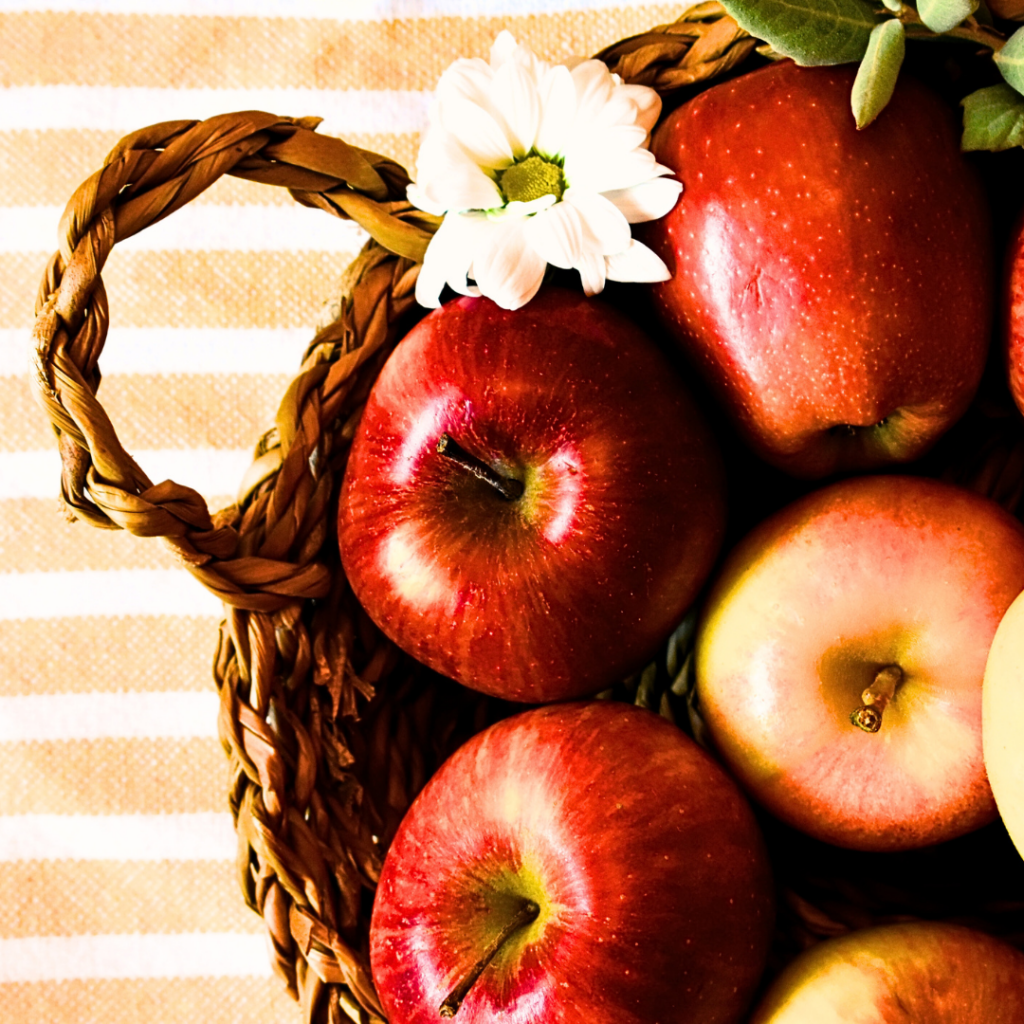
If you’re going apple picking – the perfect fall family activity (in our opinion!) – there are a few other indicators you can pay attention to.
- Don’t choose apples that have already fallen to the ground, this typically means they’re past the point of ripeness (2).
- Apples further away from the trunk of the tree will be more ripe than apples close to the trunk (2).
- If you reach up to pick an apple and it comes off easily you know you’ve got a perfectly ripe apple – if you have to pull hard to remove it, it’s not ready yet (2).
- Avoid any apples with bruises, soft spots, knicks, or holes in them, you want firm, crisp apples with smooth skin (2).
- Ask at the orchard what color the variety you’re picking should be when ripe (2).
If you’re picking the apples yourself, take care not to throw or drop the apples into the bag. Once they bruise they will go bad more quickly (2). Apples will also stay ripe for longer if you leave the stem on them when picking them from the tree (2).
Did you know?
Apples ripen six to ten times faster when left on the counter at room temperature than if stored in the fridge (3). Keeping them in the crisper drawer of your refrigerator will make them last even longer!
The best apple varieties for babies
There are so many apple varieties available of all colors and flavors, ranging from sweeter varieties like honey crisp to more sour or tangy varieties like granny smith.
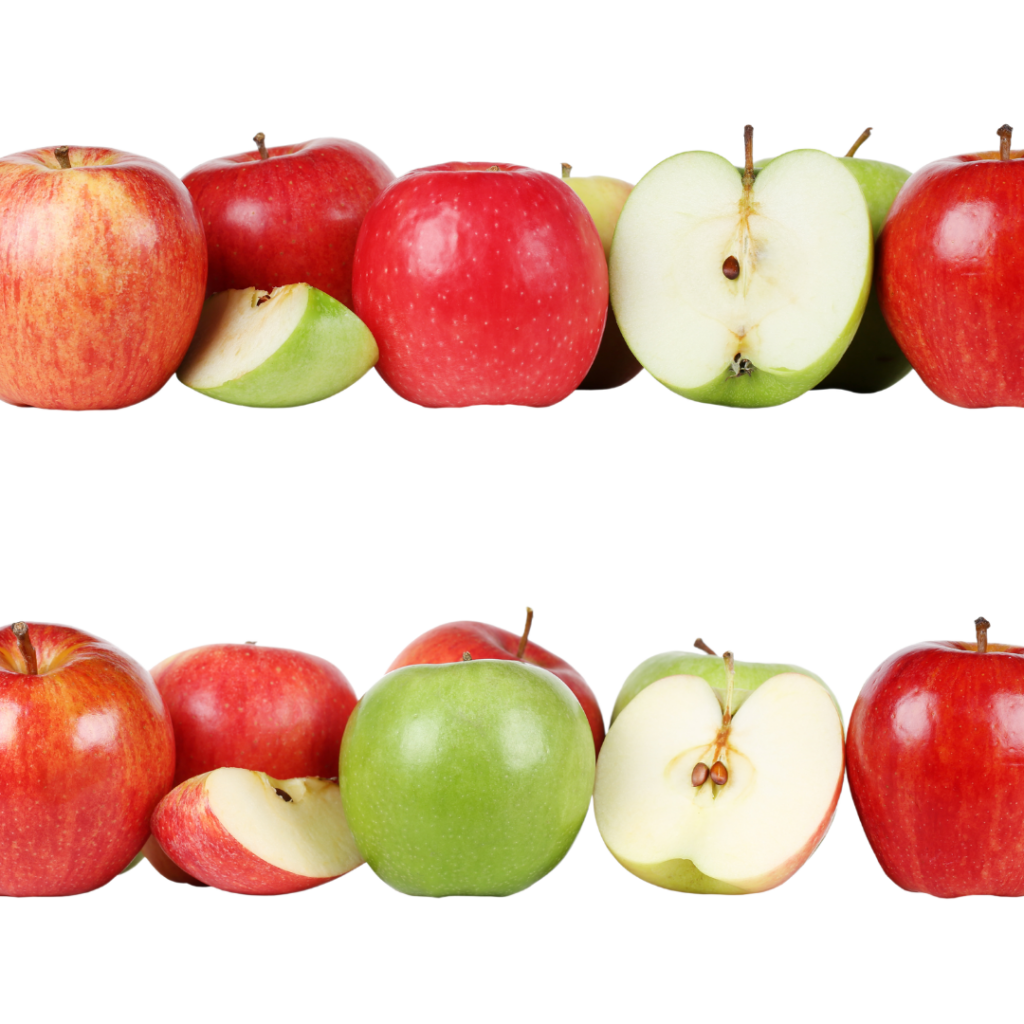
All apple varieties offer nutritional benefits for your baby and toddler. We actually recommend switching up which variety you buy in order to continually introduce your baby to new tastes so they understand not all apples will taste the same all the time.
A common reason for babies and toddlers to struggle with fruits and vegetables is their unpredictability. Bread, crackers, pasta, etc. always taste the same when served plain. But apples, blueberries, strawberries, etc. can be incredibly sweet or incredibly sour depending on the variety and how fresh or ripe they are when served. The unknown can make children, toddlers especially, more hesitant to try it because they don’t know what they’re getting and that can cause them to fear it.
Purchase a different variety of apple, or alternate between a sweet variety and a sour variety (depending on what you have available). This can help your child learn to expect apples to taste different and help them become more comfortable with that reality.
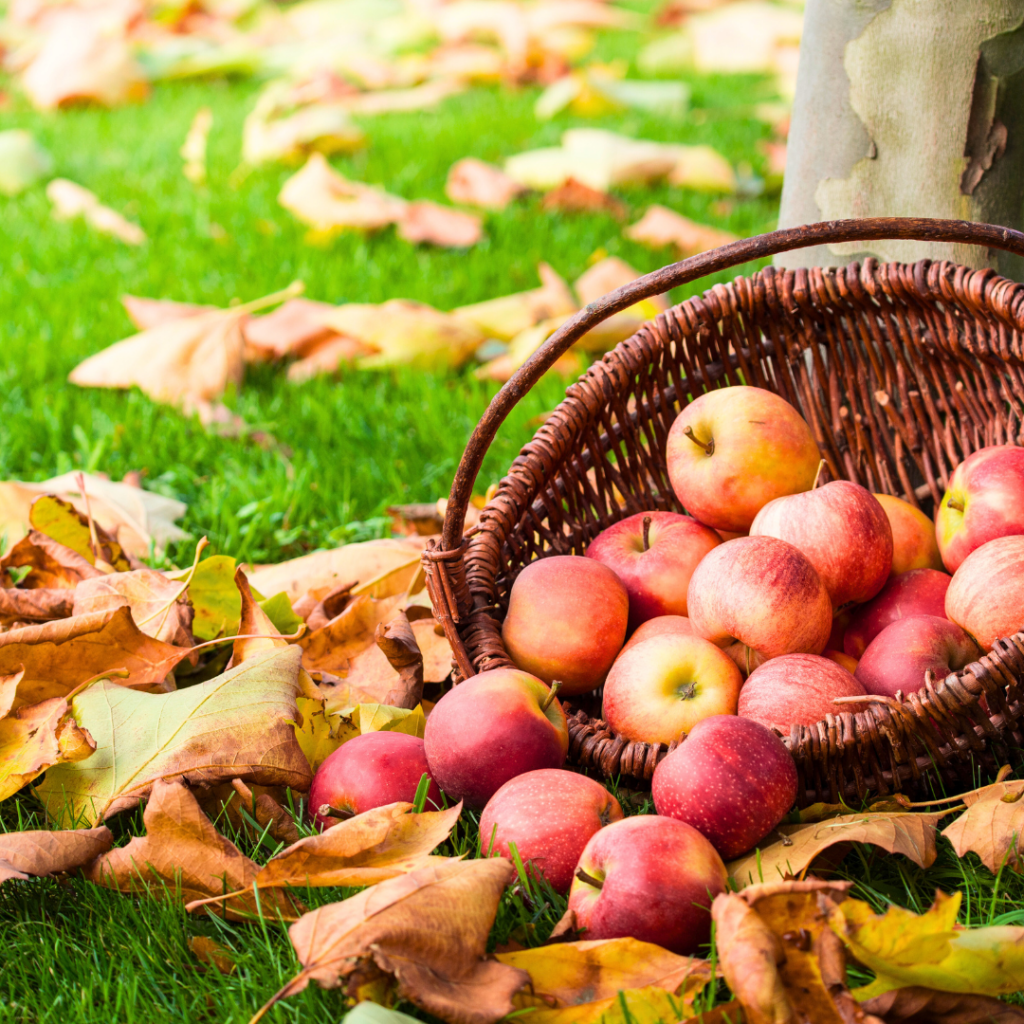
A great way to do this is to follow the order in which apples ripen in the fall months. Different varieties are ready to pick at different times. Choose the variety that became ready to pick around the time that you’re buying, and then switch it up in a couple of weeks when a new variety ripens.
This is an easy way to choose which apple to buy and it will have you eating apples at their peak ripeness when their texture and flavor are often best.
Learn more about the best fruits and vegetables to purchase in the fall months.
How to serve apples according to the Texture Timeline™
These are the safest, suggested ways to serve food to your baby based on the scientific, developmental, and clinical research and expertise available to date and are vetted by leading pediatric doctors, speech-language pathologists, and dietitians. However, please note that babies can technically choke on anything, including purees. Always take into account your child’s individual abilities and needs and check with your doctor or feeding therapist on the safety of offering these foods to your baby. Be mindful of how to set up a safe eating environment and please know that all material, opinions, advice, and information found on mylittleeater.com is for informational and educational purposes only. See our disclaimer for more information.
What is the Texture Timeline™?
A tool exclusive to My Little Eater that allows you to start solids with your baby using purées, finger foods, or a mixture of both. We sort all foods into different phases of the timeline based on texture difficulty, presenting multiple ways to serve each food depending on what you and your baby are ready for.
You can start with any phase of the Texture Timeline™. The goal is to always be moving forward on the timeline so that you can advance your baby to more challenging textures in a timely manner. This will allow your baby to develop and practice new eating skills and ensure that they don’t stay stuck on one texture for too long.
Using the Texture Timeline™ can help to prevent picky eating, all while keeping the feeding process enjoyable and less stressful for you because you can ease into the difficult textures that often cause more anxiety and worry.
Apples are at the top of the list of fruit that has the highest levels of pesticide residue (1). Therefore, the very first step is always to thoroughly wash the fruit before cutting. You can clean it by rinsing it underwater and gently rubbing the skin with your hands to remove any residue.
Texture Timeline™ Phase 0
Pureed (Utensil)
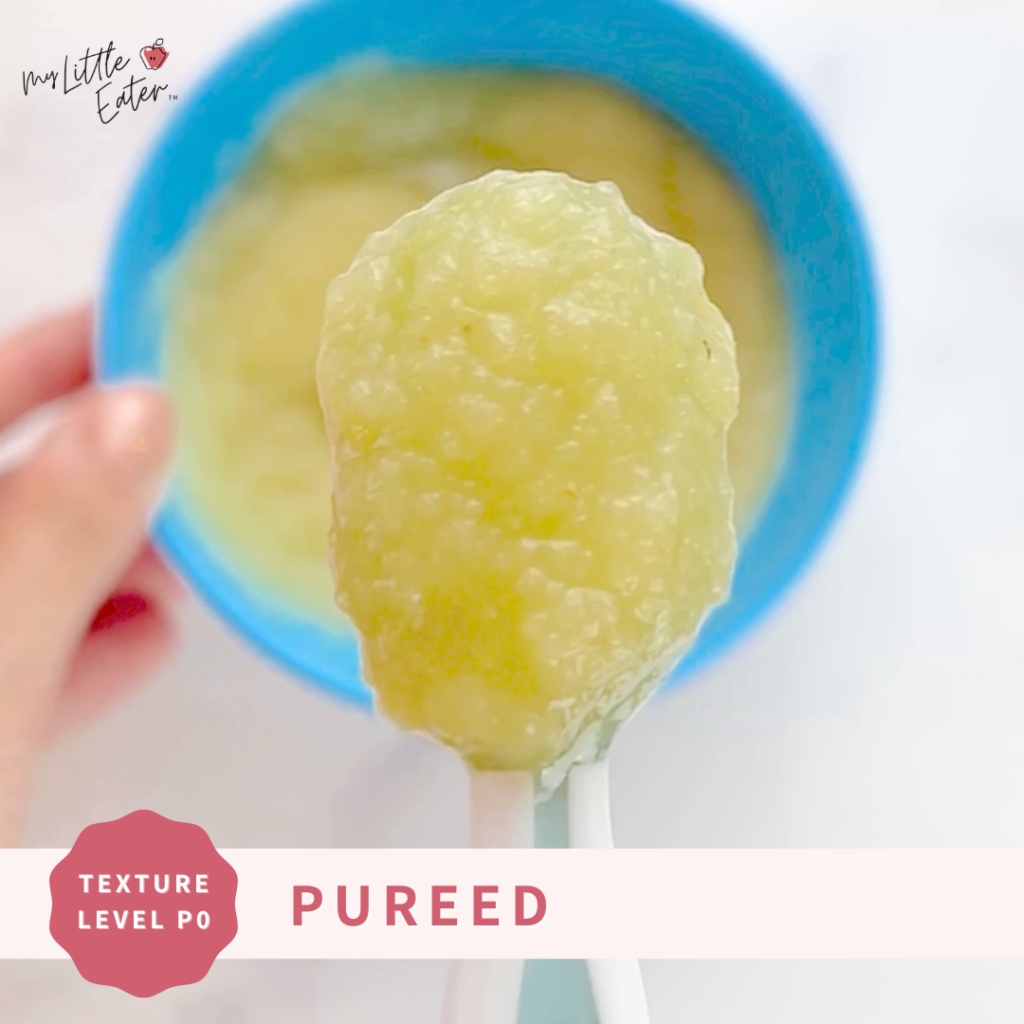
You can serve your baby blended, cooked apples or applesauce on a preloaded spoon. If your baby isn’t interested in using a preloaded spoon, you can let them dig in with their hands!
Check out our easy, slow-cooker applesauce recipe below!
Texture Timeline™ Phase 1
Cooked + mashed (Utensil)
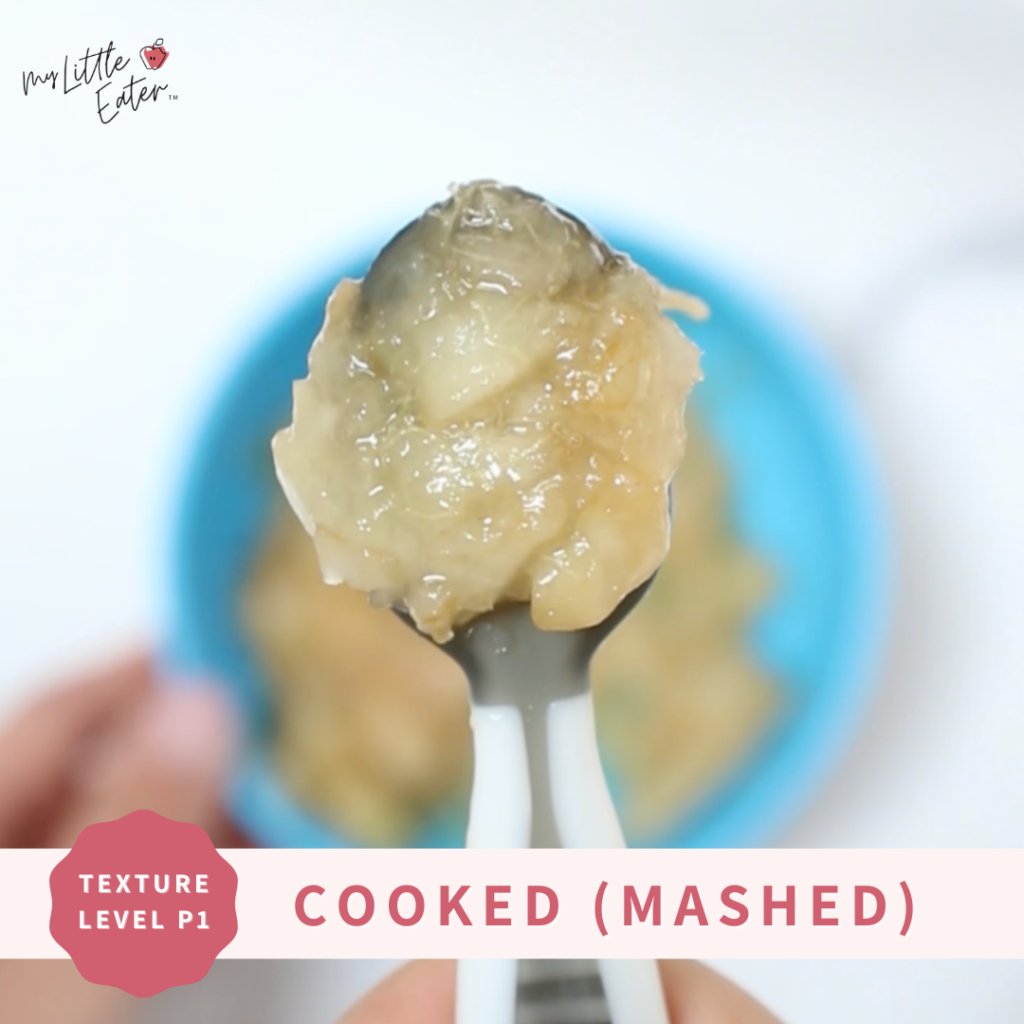
When serving cooked apples to your baby, including small, soft lumps that are cohesive is ok as they can be easily mashed by the tongue.
Serve this option to your baby on a preloaded spoon for them to self-feed, or you can spoon-feed it to them. If your baby isn’t interested in using a preloaded spoon, you can let them dig in with their hands!
Texture Timeline™ Phase 1
Cooked + halved (Palmar Grasp)
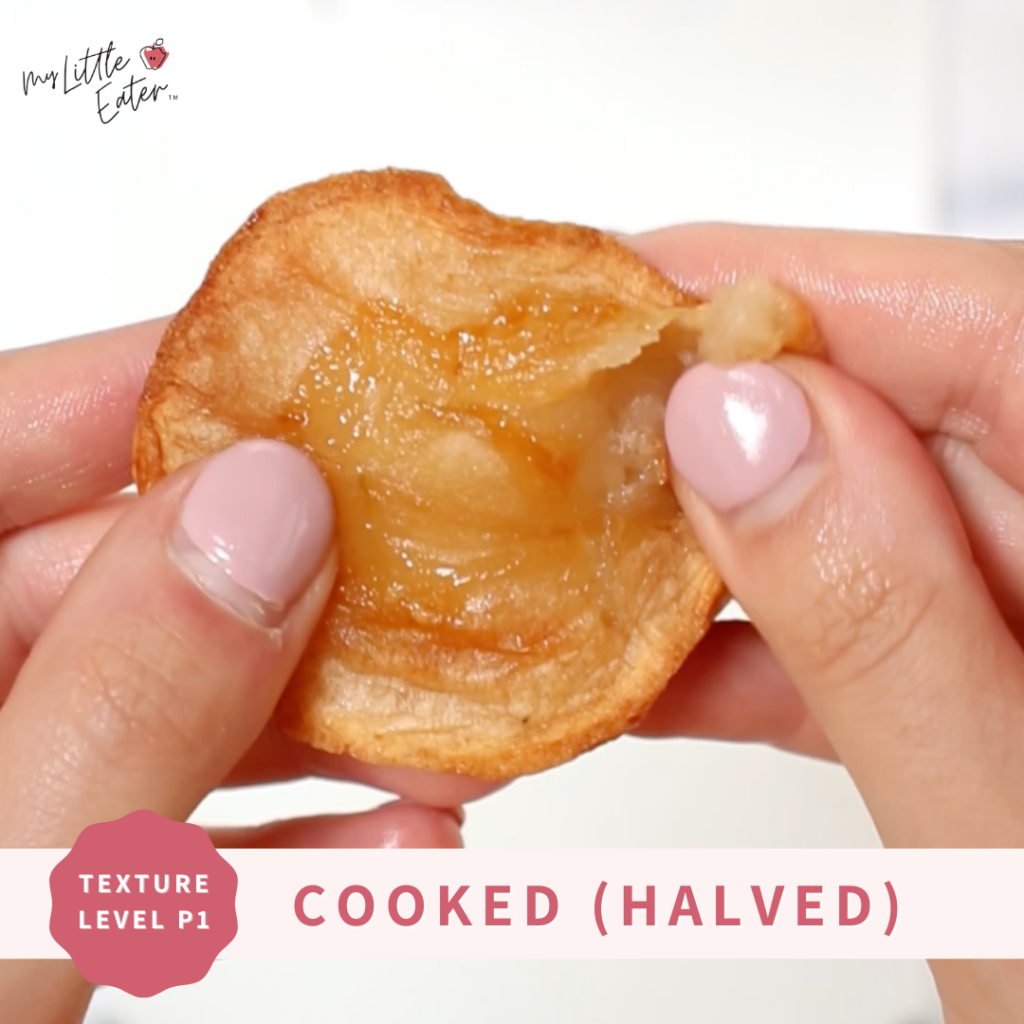
Step 1: Wash the apple and remove the skin.
Step 2: Place the apple on a cutting board. Place your knife on one side of the apple core, cutting the remaining half of the apple.
Step 3: Bake, poach, or boil the apple until it’s tender and soft enough for your baby to mash with their gums.
Step 4: Once the apple has cooled, offer to your baby to eat using their palmar grasp.
Texture Timeline™ Phase 1
Cooked + wedges (Palmar Grasp)
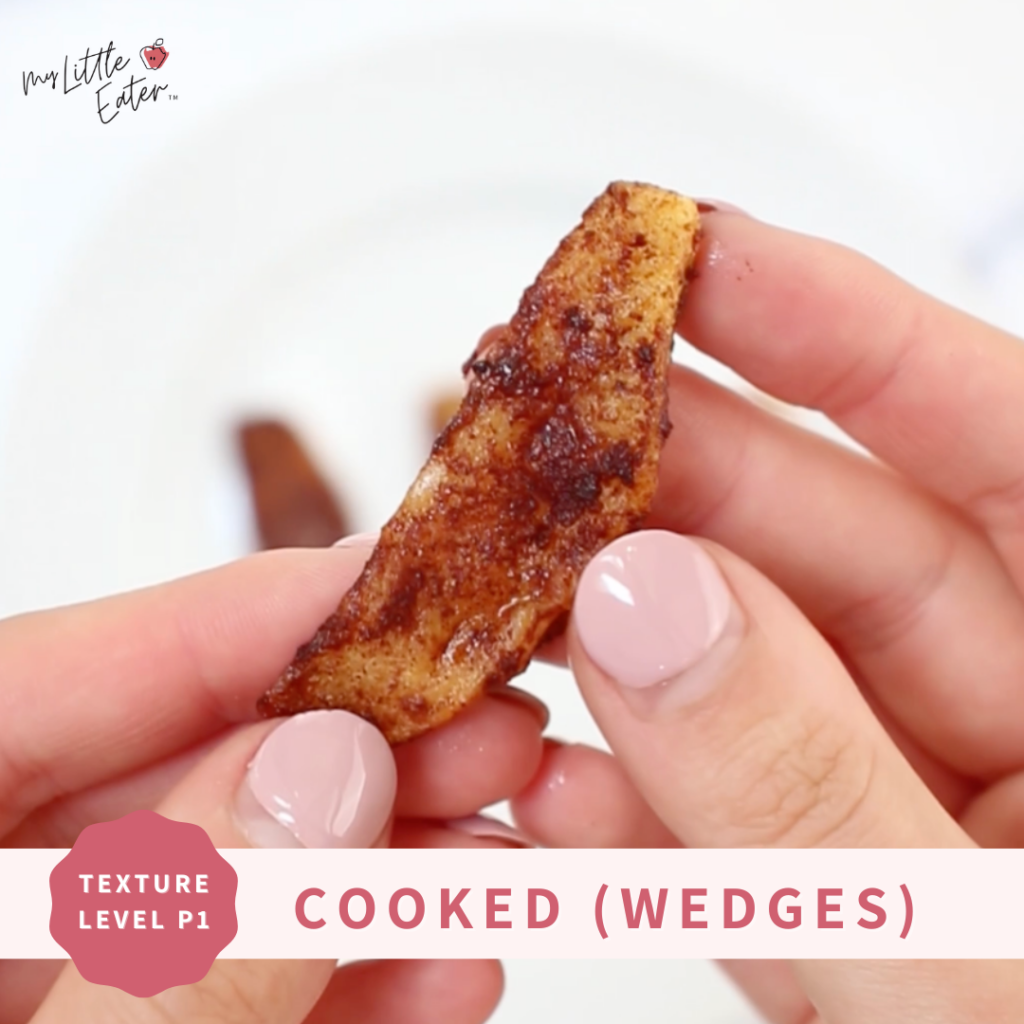
Step 1: Wash the apple and remove the skin.
Step 2: Place the apple on a cutting board. Cut the apple into thinly sliced wedges, approximately ½ an inch thick on the outer edge.
Step 3: Bake or cook the apple wedges in a pan with butter or water until soft. Add a dash of cinnamon for a delicious flavor experience for your baby!
Step 4: Once the apple has cooled, offer to your baby to eat using their palmar grasp.
Texture Timeline™ Phase 1
Cooked + diced (Pincer Grasp)
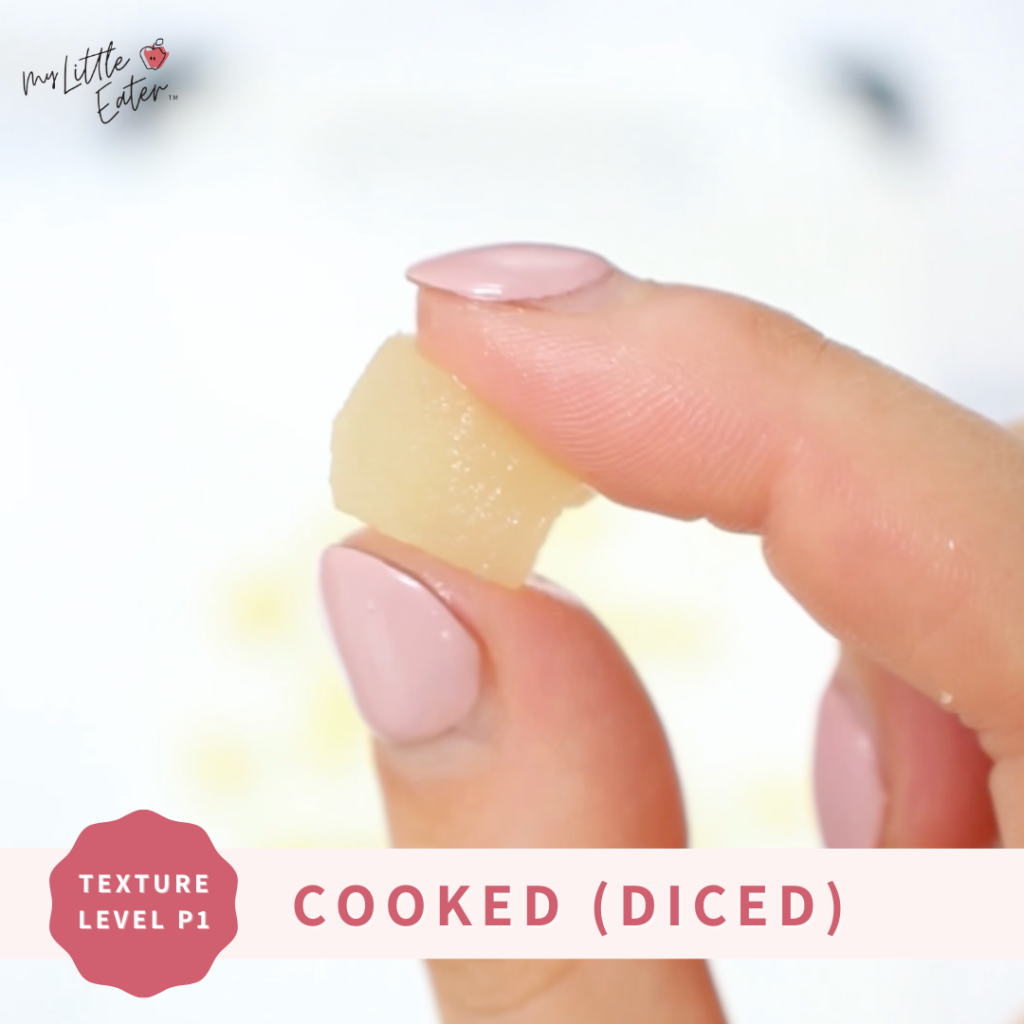
Step 1: Wash the apple and remove the skin.
Step 2: Place the apple on a cutting board. Dice the raw apple into ½ inch cubes.
Step 3: Cook the diced apple pieces in a pan with butter or water until soft. Add a dash of cinnamon, if desired.
Step 4: Once the diced apple has cooled, offer to your baby to eat using their pincer grasp.
Texture Timeline™ Phase 2
Grated + raw + mixed with a binder (Utensil or Pincer Grasp)
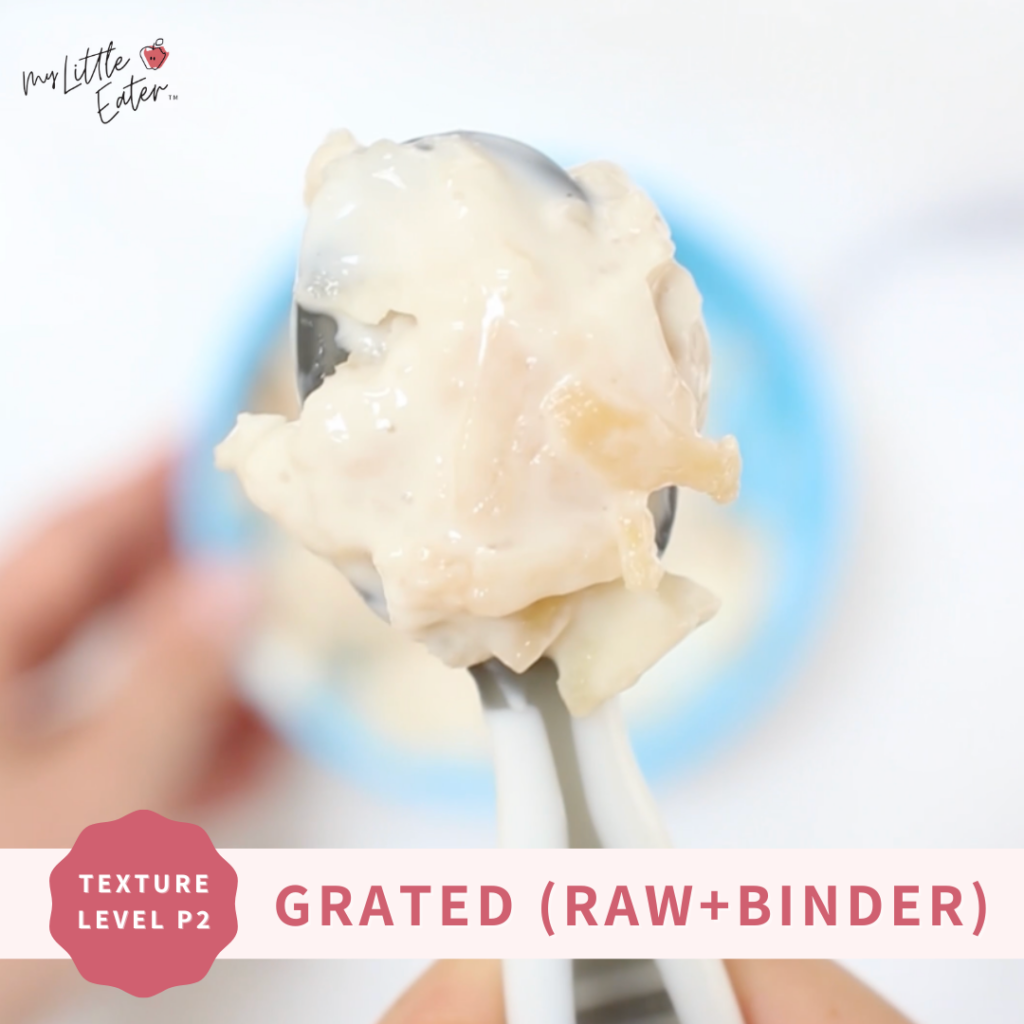
Step 1: Wash the apple and remove the skin.
Step 2: Grate the raw apple using a cheese grater.
Step 3: Mix the grated apple into a puree to bind the pieces together and add more moisture. You can use Greek yogurt, hummus, or avocado!
Step 4: Serve to your baby on a preloaded spoon for them to self-feed, or you can spoon-feed it to them. If your baby isn’t interested in using a preloaded spoon, you can let them dig in with their hands!
Texture Timeline™ Phase 3
Raw + paper thin slices (Palmar Grasp)

Step 1: Wash the apple and remove the skin.
Step 2: Grate the raw apple into very thin slices using a mandolin or the slicing side of a cheese grater. The pieces should be bendable and somewhat see-through.
Step 3: Offer to your baby to eat using their palmar grasp.
Texture Timeline™ Phase 3
Raw + grated (Pincer Grasp)
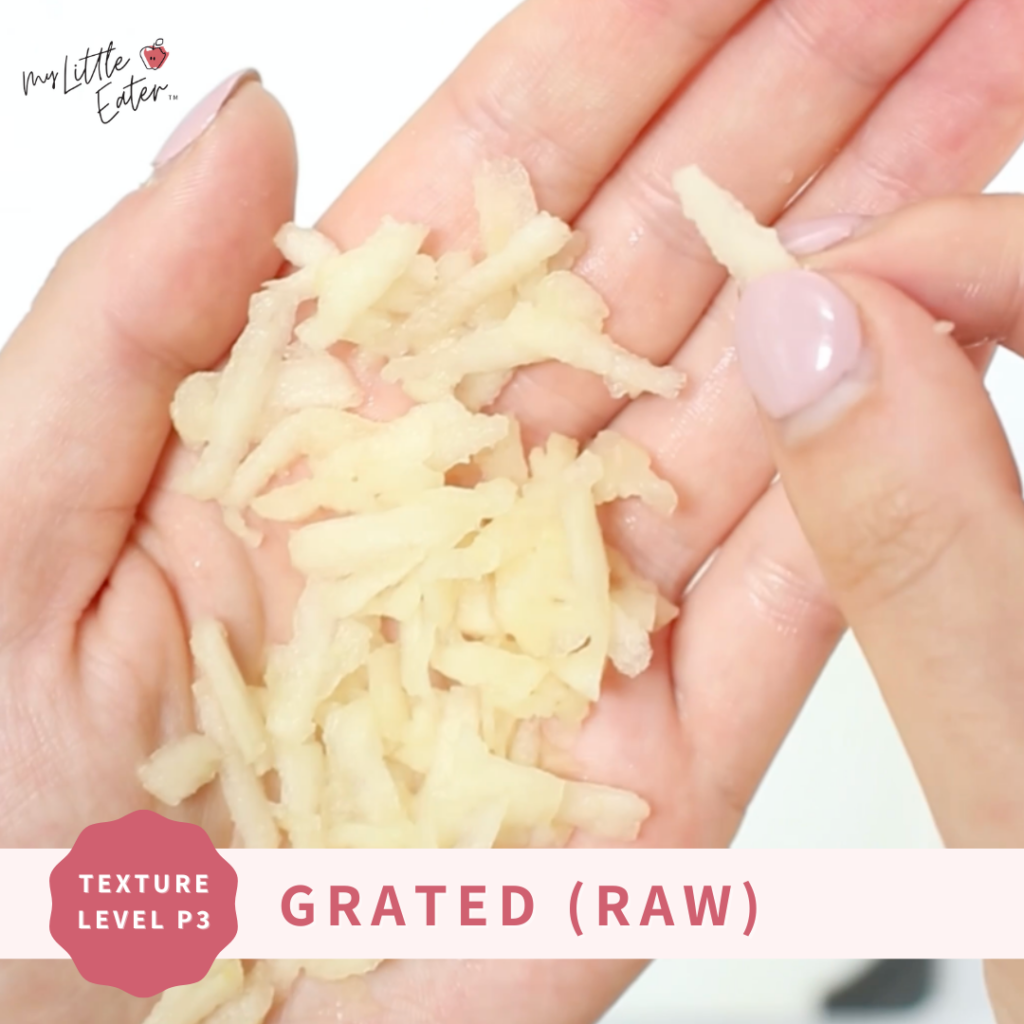
Step 1: Wash the apple and remove the skin.
Step 2: Thinly grate raw, ripe apples for a shredded texture experience for your baby. Ensure the apple is ripe enough that it can be squished (but doesn’t instantly dissolve) between your thumb and forefinger.
Step 3: Serve to your baby to eat using their pincer grasp.
How to store cut apples
As we’re sure you’ve experienced before, apples will quickly turn brown once they’ve been cut due to the flesh of the apple being exposed to oxygen. This often results in parents tossing the leftovers instead of keeping them for their baby to eat the following day. And we know how frustrating wasting food like that can be!
Before we get into tips for how you can preserve the apples to serve again, we also want to note that just because an apple has browned doesn’t mean that it has “gone bad”(4). They are still perfectly fine to eat and often taste exactly the same. The browning is not indicative of the apple rotting, rather it’s a reaction between the oxygen and a compound in the flesh of the apple and is nothing to be concerned about.
If you cooked the apple to soften it, store the cooked pieces in an airtight container in the fridge. These should be ok to serve the following day to your baby, but will likely be too mushy or mealy to serve to your baby if kept longer than that, unless serving them pureed or mashed.
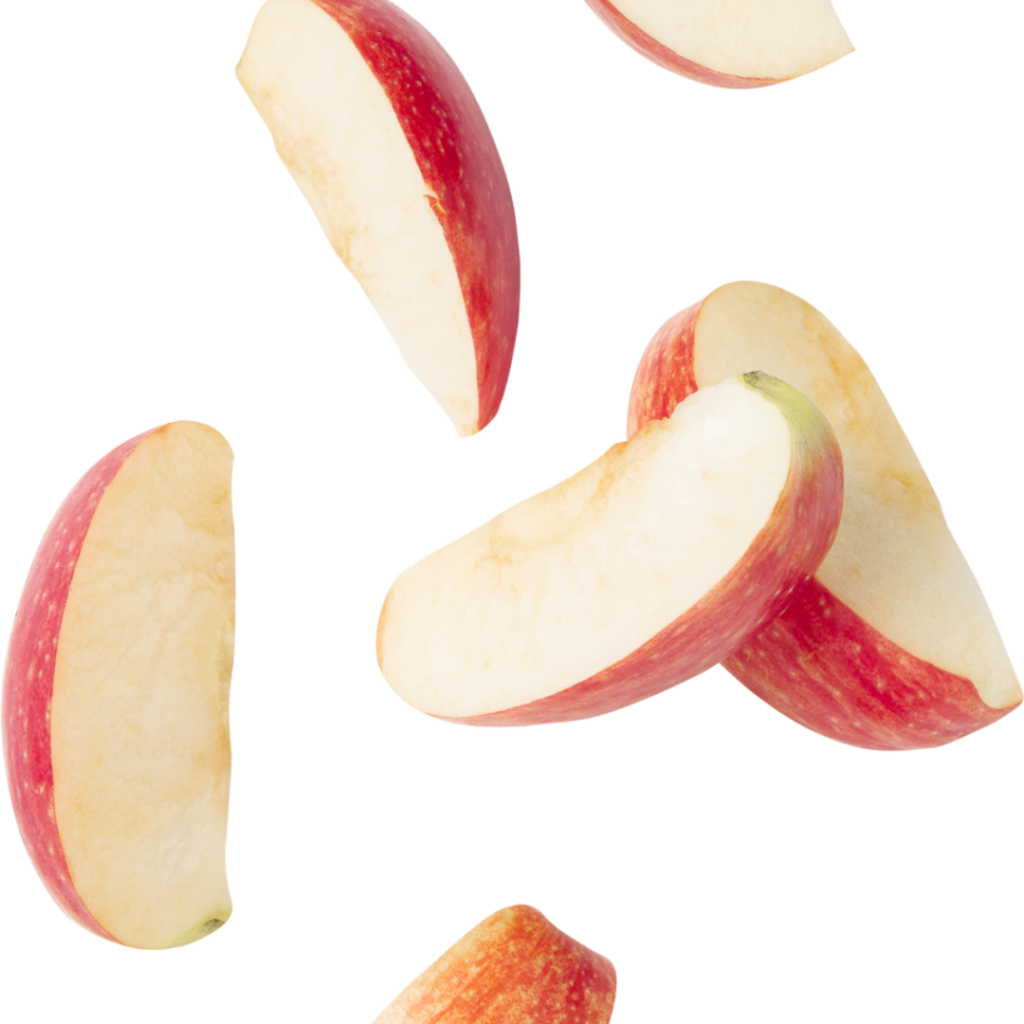
If you offered one of the raw options described above, you can try squeezing a bit of lemon juice on the apple before storing it to prevent it from turning brown as quickly (4). Mix the apple after adding the lemon juice to ensure it has been thoroughly coated (you can even soak the apple in lemon juice if you prefer) then store it in an airtight container in the fridge.
We recommend offering these to your baby later on in the same day because even with the lemon juice they won’t last long in the fridge (likely just 6-7 hours) and will probably brown by the following day (4).
Nutritional benefits
Apples are rich in quercetin and pectin, both of which provide various health benefits (1). Quercetin is a naturally occurring plant chemical, known for its antioxidant and anti-inflammatory effects (1). Pectin is a type of soluble fiber, useful for preventing constipation (1).
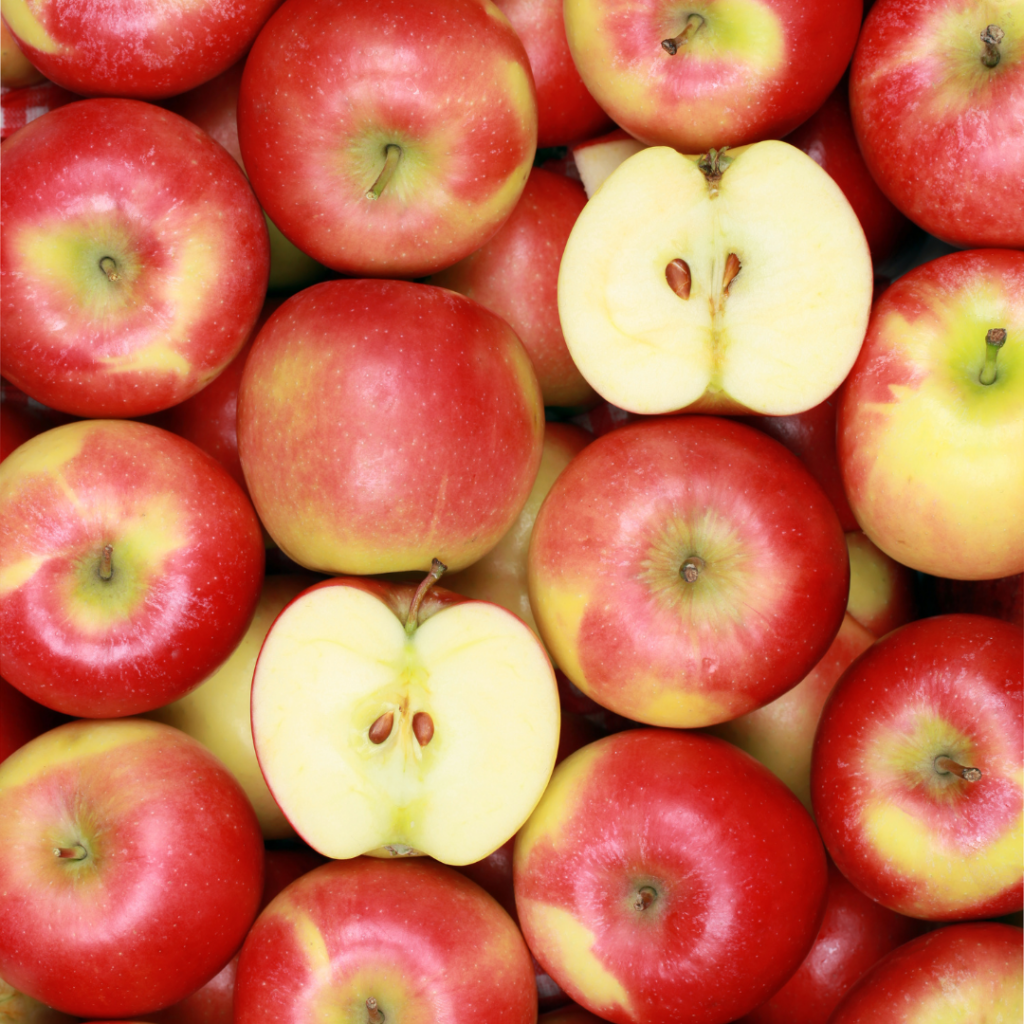
Apples provide additional beneficial nutrients for your baby, including (1):
- Insoluble fiber for gut health and digestion
- Vitamin C for immunity and skin health, and to improve the absorption of plant-based iron sources
- Vitamin B6 for creating antibodies to fight sickness and promote normal nerve function
An apple a day...
…keeps the doctor away?
This common saying originated in the 1800s in Wales and continues to be a popular saying today (5). But is it true?
While incredibly difficult to research accurately to determine a true causal relationship, a study was conducted in 2015 attempting to determine if this saying had value. Their conclusion, while acknowledging the limitations of their research, was that if anything the saying should be “An apple a day keeps the pharmacist away” (5).
It seems that there may be some sort of relationship between eating an apple a day and avoiding the use of prescription medications (although more research would be required to say this definitively) (5). But they couldn’t say that there was a clear relationship between eating an apple a day and avoiding doctor visits (5).
Still, it’s a fun saying with an easy reminder about the importance of including nutrient rich foods, like apples, in your daily diet!
Can babies be allergic to apples?
Apples are not one of the top 10 highly allergenic foods and can be introduced alongside other non-highly allergenic foods without having to wait (the 2-day wait rule is for top allergens only).

Allergies to apples are rare, but not impossible! It’s possible to develop oral allergy syndrome (OAS), also commonly called Pollen Food Allergy Syndrome (PFAS).
OAS is a cross-reactive reaction that occurs in those who are allergic to pollen, which has similar proteins found in many fresh fruits and vegetables. This results in an allergic reaction when those raw fruits and vegetables come in contact with the mouth and throat (6).
OAS is considered to be a mild food allergy and symptoms (swelling or itchiness of the mouth, face, lips, tongue, or throat) usually appear within a few minutes, and up to one hour after. (6).
If you suspect your baby or toddler has an allergy, it is best to consult with your doctor for appropriate treatment, diagnosis, and medical advice.
Apple FAQs
Can babies drink apple juice?
We don’t recommend offering your baby any apple juice.
Apples are much more nutritious in their whole form rather than as juice because whole apples provide fiber which can help to support healthy digestion, whereas apple juice doesn’t provide any fiber (7, 8).
Juice (of any kind) also tends to have a lot of added sugar and shouldn’t be given to babies under 12 months of age (9).
Do I need to buy organic apples for my baby?
As mentioned earlier, apples are near the top of the list of foods sprayed with the most pesticides (1). For this reason, we do recommend buying organic whenever possible as it can help to limit how much pesticide residue your baby is exposed to.
Since research indicates that they may be more susceptible to the consequences of pesticide exposure, we want to be more cautious with the foods they’re being offered.
That said, if purchasing organic isn’t something you can do – we get it, it’s expensive! The nutritional benefits of apples are still there, even if non-organic varieties are offered. Regardless, always wash and scrub raw apples before serving them to your baby.
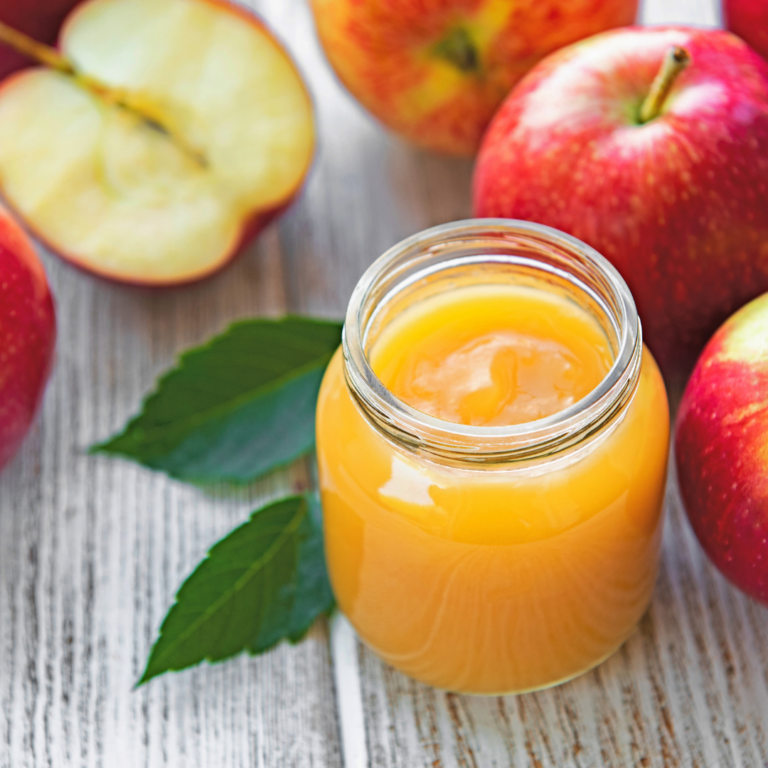
Simple slow-cooker applesauce
Equipment
- 1 Slow cooker
- 1 Vegetable peeler
- 1 immersion blender
Ingredients
- 2 Honeycrisp apples
- 5 Golden Delicious apples
- 7 Gala apples
- 2 tbsp Lemon juice
- 1 tsp Cinnamon
- ⅛ tsp Nutmeg
Instructions
- Thoroughly wash all apples before peeling them. Cut the peeled apples into wedges and place them in the crockpot.
- Add all other ingredients to the crockpot giving the apples a quick mix.
- Turn the crockpot on low and let them cook for about 6 hours until they're soft enough to blend.
- Turn off the crockpot and let the apples cool some before blending. Using an immersion blender in the slow cooker, blend the apples until they reach the desired consistency. Use caution as the mixture may still be hot and can splash if the blender is not fully immersed in the liquid.
- Serve applesauce at room temperature or chilled.
Notes
If you want to know how to serve all foods safely to your baby, how to introduce top allergens, learn about baby nutrition and balanced baby plates, get full access to our Texture Timeline™ Food Video Library, and so much more, check out our Baby Led Feeding online course!
With lifetime access and support, starting solids has never been so easy and joyful!
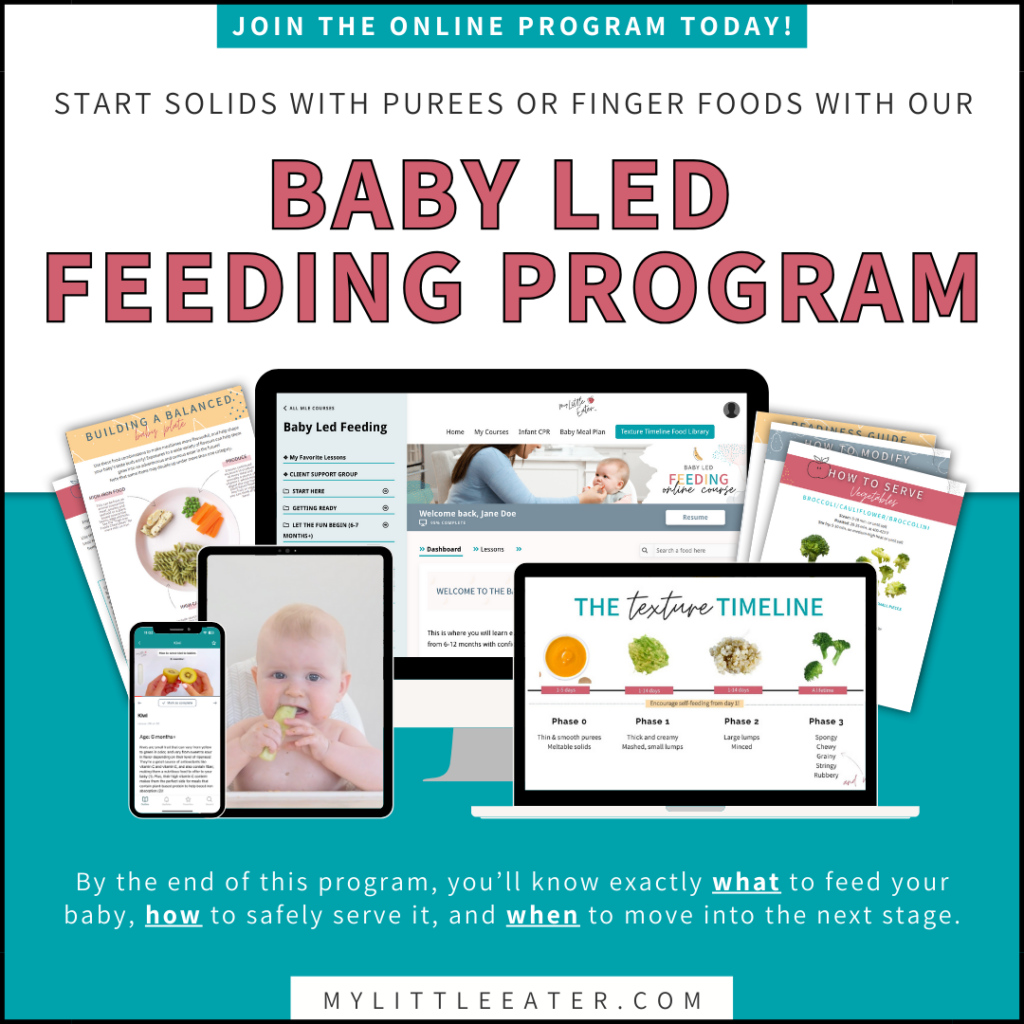
Pin it to save for later!
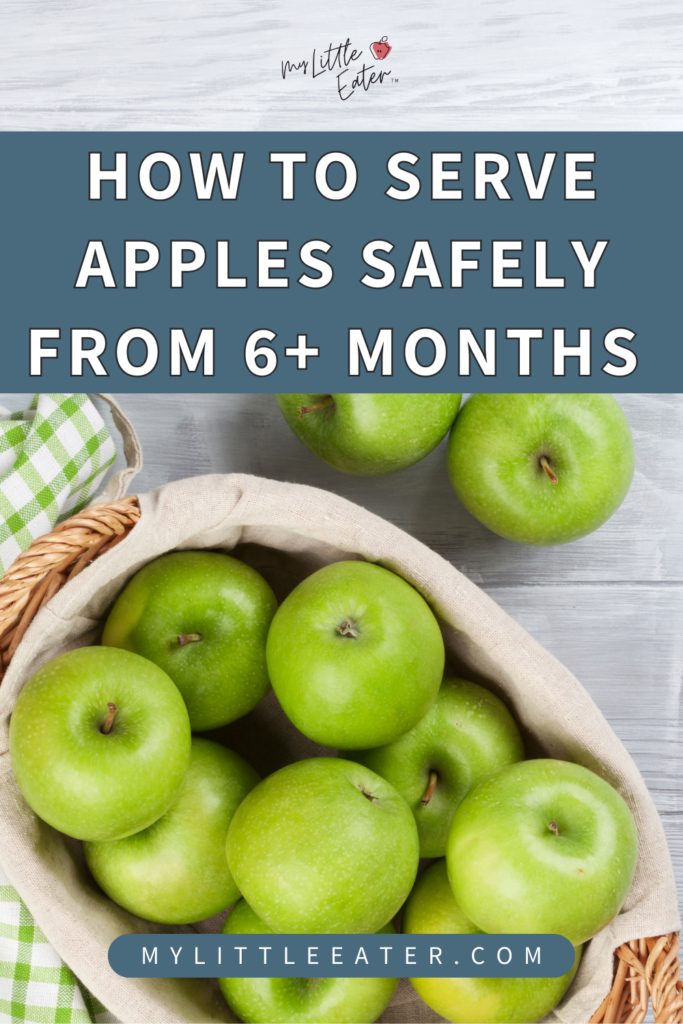
References
- Harvard School of Public Health. Apples. https://www.hsph.harvard.edu/nutritionsource/food-features/apples/
- https://www.appleholler.com/apple-picking-tips/
- https://www.appleholler.com/apple-fun-facts-2/
- https://www.epicurious.com/expert-advice/how-to-keep-apples-from-turning-brown-article#:~:text=Storing%20cut%20apples%20in%20the,if%20stored%20in%20the%20fridge
- Davis MA, Bynum JP, Sirovich BE. Association between apple consumption and physician visits: appealing the conventional wisdom that an apple a day keeps the doctor away. JAMA Intern Med. 2015 May;175(5):777-83. doi: 10.1001/jamainternmed.2014.5466. PMID: 25822137; PMCID: PMC4420713.
- American Academy of Allergy Asthma & Immunology. Oral Allergy Syndrome (OAS) or Pollen Fruit Syndrome (PFS). https://www.aaaai.org/tools-for-the-public/conditions-library/allergies/oral-allergy-syndrome-(oas)
- Brownawell, A.M., Caers, W., Gibson, G.R., Kendall, C.W.C., Lewis, K.D., Ringel, Y., & Slavin, J.L. (2012). Prebiotics and the Health Benefits of Fiber: Current Regulatory Status, Future Research, and Goals. The Journal of Nutrition, 142(5), 962-974. https://doi.org/10.3945/jn.112.158147
- U.S. Department of Agriculture. (2019). Apples, raw, with skin (Includes foods for USDA’s Food Distribution Program). https://fdc.nal.usda.gov/fdc-app.html#/food-details/171688/nutrients
- American Academy of Pediatrics: HealthyChildren.org. (2017). Where We Stand: Fruit Juice. Retrieved September 15, 2020

Chelsey Landry, RD
Community Dietitian at My Little Eater Inc., and bunny-mom to Hickory. Chelsey offers one-on-one counselling to parents of babies and toddlers that need more customized support. Learn more by booking a free discovery call with her today!

Chelsey Landry, RD
Community Dietitian at My Little Eater Inc., and bunny-mom to Hickory. Chelsey offers one-on-one counselling to parents of babies and toddlers that need more customized support. Learn more by booking a free discovery call with her today!
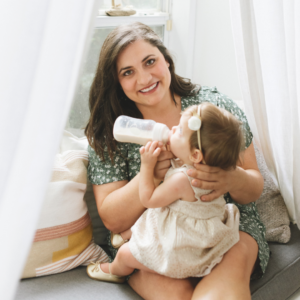
Mallory Roberts, SLP
Mallory is a Speech-Language Pathologist, Infant Feeding Specialist, and Craniosacral Therapist. She's also a busy mom of four little ones!

Mallory Roberts, SLP
Mallory is a Speech-Language Pathologist, Infant Feeding Specialist, and Craniosacral Therapist. She's also a busy mom of four little ones!
 toddler sale! 20% off toddler program with code Toddler20 at checkout
toddler sale! 20% off toddler program with code Toddler20 at checkout 